A Deep Dive into the World of Seafood & Sushi
Picture of Sushi Kaya in Chinatown by George Bentley Lagason. This depicts the restaurant where I base my judgment for this piece.
December 1, 2022
For those who may not know me, here’s something about me I want you all to know, I am a big guy, and as a big guy, I love food. Food is a passion of mine and it fuels life and brings memories to people for generations. Sushi is at the top of my personal food pantheon. You just honestly can’t beat it. It comes great in a variety of forms like cold, hot, baked, deep fried, gunkan, temari, makizushi, chirashizushi/poke, nigiri, temaki, and much more! Rice and seaweed are two of the three important core components of sushi. The third component is, of course, the seafood! Seafood is the core filling for sushi and the general occupants of the sea. They come in many different shapes, sizes, families, and parts of the water. One thing in common they all have is that I love to eat them! I’m very much a seafood lover, so I’m glad to say that I’m here to present my seafood ranking to you.
I will be ranking this in a particular set of criteria. I’ll go into an analysis of each seafood and give them three scores. Those three scores will be base, modified, and overall. Base is a blanket term with a ranking of how they are in their raw or most basic forms. Modified is just also a general statement used for all styles of seafood preparation like searing, boiling, steaming, marinating, toppings, etc. I will be making exceptions for some seafood such as shrimp due to their base forms in sushi restaurants usually being boiled. I am basing the pure taste aspects of this on Sushi Kaya in Chinatown which I visited Saturday, 11/12/22. Every place is different so I am recalling general experiences in various restaurants but primarily pulling from the time I had at Sushi Kaya. So with that being said everyone, shuck open an oyster, put on your chef’s hats, and tuck in your napkin because here’s a big Filipino man giving you his opinions on seafood.
Maguro (Tuna)
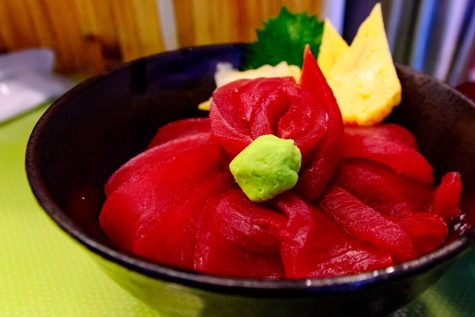
Maguro or as most of us know it, tuna, is one of the staple seafoods of sushi. This is one of the most commonly pictured seafood used in sushi for things like TV shows, anime, etc. As a base, it’s pretty solid overall. It’s a fairly meaty fish, if done right its texture is almost buttery, and shouldn’t be fishy if it is good quality. There are many different types of tuna species which vary depending on where they’re caught. Some of these include skipjack, yellowtail, bluefin, etc. There are several parts used for sushi and things of the sort. The akami (back meat) is commonly what you see shingled atop your Sushi rolls and as the blanket for your nigiri. There’s also the o-toro (fatty tuna belly), commonly laid upon balls of rice for nigiri or chopped up and placed atop a gunkan. These parts are the crowning jewels of the right fish. It is without a doubt the most expensive part due to its intense fat marbling which allows for it to have a melt-in-your-mouth kind of feel which makes it feel like the treasure of the sushi world. People pay a pretty penny for this, and rightfully so as the freshest kinds of whole tuna can be gold at the hands of a proper chef. Variations on this classic fish are vast. This fish has been topped with a variety of citrus, and garlic mayonnaise, mixed in with spicy sauce, seasoned in cajun spice or marinated in soy sauce, and much more. Tuna isn’t quite my personal favorite in terms of both base form and modified form, but I do enjoy it and I think it’s a solid baseline overall. Some points get taken off of the modified score as I feel like it’s not as good as others but seared tuna, among other things, carries the modified category for tuna. Overall it’s an absolutely stunning piece of fish that can be experimented on to create life-changing dishes.
Base: 9/10
Modified: 8/10
Overall: 8.5/10
Salmon

Salmon is another one of the staples in sushi. This is also one of my favorite sushi components. To my knowledge, usually, two parts are used. The belly of the salmon and the thinner part of the salmon are utilized. The taste is absolutely special. Compared to its common counterpart, tuna, salmon is fattier. It still has that meaty texture and it’s just absolutely spectacular. From a price standpoint, it is also cheaper compared to tuna. This allows for a better sushi material at home when you buy this seafood for a cheaper price. Modifications are vast and in my opinion, personally better than tuna. Modifications include being topped with garlic mayo and cheese, seared, miso-glazed, broiled, fried, and just decorated with a variety of toppings. Overall, I prefer tuna at base but salmon has a sheer variety of variations that trumps tuna. Salmon is a prime example of all the things you can do with seafood.
Base: 8/10
Modified: 10/10
Overall: 9/10
Squid
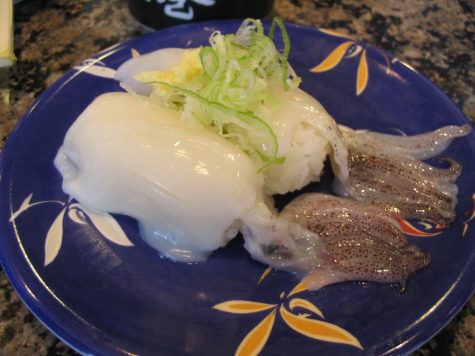
Squid is an interesting one. This animal comes from the cephalopod family of sea creatures which includes a fellow animal on this list, the octopus. The hood of the squid is the main part used in sushi although tentacles are used on occasion. After peeling the thin layer of skin off, a chef commonly slices it thinly before putting it atop the rice ball. To my knowledge, a lot of the guts, the beak, and the quill of the squid get discarded before properly using the squid to make sushi. This is due to the fact that those parts are generally either undesirable or inedible. The usual accompaniments for the squid are the shiso leaf (which is an herb that has a strong flavor reminiscent of a hybrid of herbs including mint, basil and things of the sort), and lemon. Squid faces a similar problem to the sea urchin in that it doesn’t have that much variation to the base seafood. Its saving grace in that point category is fried squid. When you’re in the right place, it is absolutely amazing and it gives the squid a higher favor to its merits when modified. If you wanna branch out of the section of fish and into the family of cephalopods, squid is a good place to start.
Base: 7/10
Modified: 3/10
Overall: 5/10
Tako (Octopus)
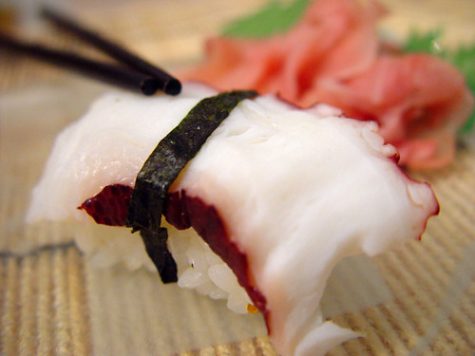
From one cephalopod to the other, we have the octopus. This one to me is better compared to the squid for me overall. The preparation methods used on the octopus are quite intriguing. The octopus is massaged and beaten by a wooden rolling pin to basically make it tender and more flavorful. Then it is boiled/steamed to cook it. This gives it a mildly chewy texture which I personally enjoy. It is not to the point where it’s difficult to eat. The most common accompaniment with this is usually some sort of glaze with soy sauce. It’s sad to see the lack of variation in the octopus. It’s still an overall solid seafood that just doesn’t do well in terms of ranking. If you want something that gives you a solid bite for your buck, the octopus would be your kind of food.
Base: 8/10
Modified: 1/10
Overall: 4.5/10
Uni (Sea Urchin)
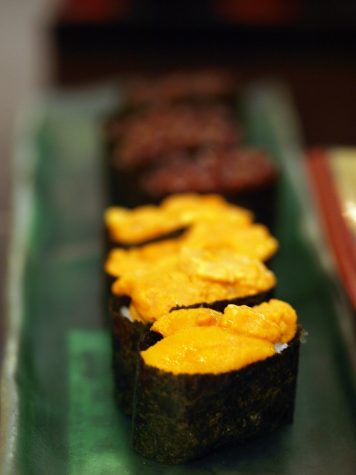
(“Sea Urchin Sushi” by Taekwonweirdo is licensed under CC BY-NC-SA 2.0.)
Uni or Sea Urchin is a delicacy commonly found on top of gunkan maki sushi, which is a standing roll with rice wrapped around the sushi, providing a little indent to put your toppings on top. Uni is a special kind of seafood. The part of Uni we look for when we eat is their reproductive glands. They are guarded by a sharp and spiky shell that you can find along the beach so be careful! Once we crack past that barrier, we find the jewels, their reproductive glands. They’re usually yellowish in color and fall apart with too much force so be delicate when handling them. They’ve been described as ‘sea butter’ and their taste lives up to it. It just hits you with a burst of flavor that is reminiscent of the sea. It’s an acquired taste so not all new people would be accustomed to the strong and powerful taste. Unfortunately, the overall score of this seafood is brought down by its sheer lack of modification. The only ones I can give it are torched and baked which are fine in their own right. This, however, is just a testament to how good the seafood is on its own, which is merit in its own right. If you want something that would get you hooked if you ever get the chance to try, I definitely suggest giving sea urchin a try.
Base: 10/10
Modified: 2/10
Overall: 6/10
Ebi (Shrimp)
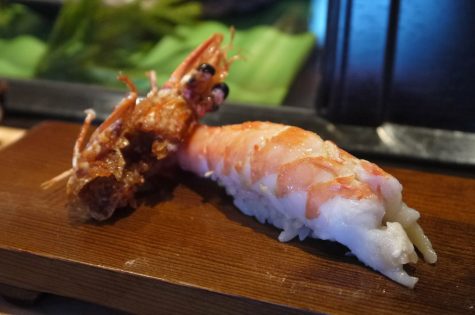
This one is a solid overall one. We don’t really get this one that much because my father is allergic but when I do have this one, it is very enjoyable. Shrimp can be served in various ways in sushi. It could be Shrimp with the head on, head off, whole, etc. This crustacean isn’t my personal favorite but it is very versatile, being able to be used in various ways which dip into variations. One of the most prominent ones is tempura fried shrimp. If done right, it should be light but still crisp and just beautiful. Those fried delights are always in sushi rolls, either on top or in it. It isn’t the best on its own but it is a very strong team player kind of seafood, complimenting others and bringing out the textures and flavors of the other seafood and sauces of the sushi. If you want a solid overall pick, shrimp would be right up your alley.
Base: 5/10
Modified: 7/10
Overall: 6/10
Scallop
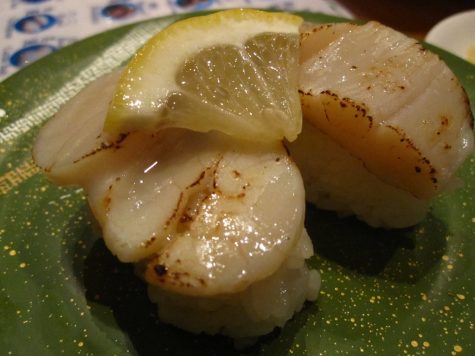
Up next is the only mollusk on the list. Scallops are little meaty medallions that are absolutely lovely in seafood. These little guys are usually resting in a shell that you gotta shuck open. It’s actually an interesting process that I personally wanna learn but I won’t get into that right now. However, once you shuck that shell and pry it open, you get the absolute jewel of the scallop. The scallop in itself is meaty, tender, and buttery. The scallop is also fairly light without being too heavy. Moderations on this are quite basic but basic can be good. Baby scallops, a smaller species of scallop, are discarded from their shells and mixed into a bowl with Japanese mayonnaise and fish eggs to make some sort of mix that is put on top of the gunkan sushi. Another variation is the scallop seared with mayonnaise adourning it. This is similar to the shrimp in that it’s a very versatile mollusk that can provide a lovely bite. However, I prefer the shrimp more in terms of variation but scallops are better in their base form. These two in my opinion are around the same ranks on the list. However, I still enjoy the scallop nonetheless. If you’re looking for a small surprise in a shell, the scallop suits you to your satisfaction.
Base: 6/10
Modified: 6/10
Overall: 6/10
Unagi (Eel)
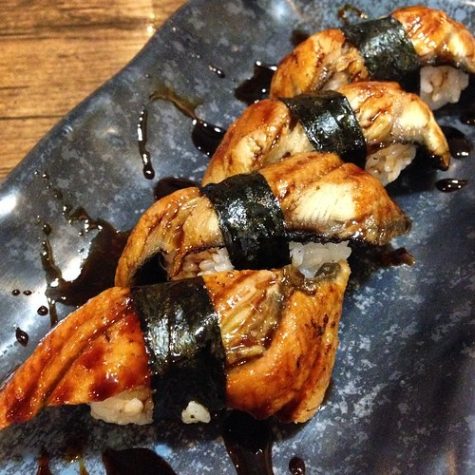
From the only teleost fish on the list, we have the eel. This slimy fellow is usually in the sea like a water snake. In terms of preparation for this fish, they peel the skin back to get rid of all that slimy stuff and then they remove the portion of the meat commonly used. Then they skewer it and grill it. Most commonly, the fish is glazed with a sauce combination. I am not the biggest fan of the eel as the taste just isn’t to my liking. The sauce saves it from being worse in my opinion and I find that it is better on rolls, but this isn’t really my jam. The sauce however is good off of the eel, with it being semi-sweet it compliments the eel well. That would explain the namesake of the sauce. Not to say that I hate it but it just isn’t to my taste. Overall I think it’s a solid choice, just not my favorite. If you’re looking for something more cooked, eel is a solid way of easing into sushi.
Base: 3/10
Modified: 5/10
Overall: 4/10
Mackerel
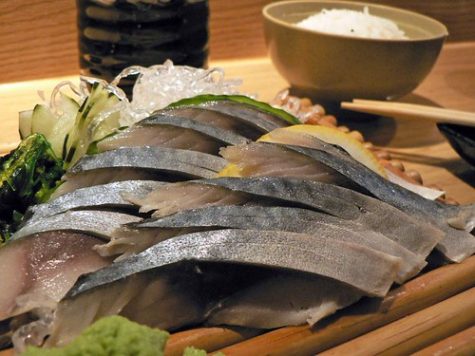
Saba, or mackerel, is my father’s favorite whenever we order sushi. I can definitely see why. This fish falls apart nicely which provides an amazing texture. The fish actually has a deep-rooted history with sushi as way back then, the fish was cured in a mixture of salt and vinegar. The fish has firm yet oily skin which is easy to break through and the flesh is pretty tender tender when you bite into it. This fatty fish is rich in flavor which allows it to be more efficiently paired. This fish is commonly paired with a lot of citruses and is complimented by soy sauce. Things that can cut down the fat and richness of the mackerel work delightfully with this. This causes a flavor of contrasting proportions. This is a very strong individual fish as it has such a strong flavor like the uni. The problem, however, is that it has less compatibility with other fish which won’t affect the rankings here but it’s why you don’t see it much in sushi rolls. This is practically the spear of the sushi world, powerful strong flavor/attack, but less of a defensive/compatible tool. If you want something that packs a punch of taste but nothing too crazy, mackerel is your kind of fish.
Base: 9/10
Modified: 4/10
Overall: 6.5/10
Ikura (Salmon Roe)
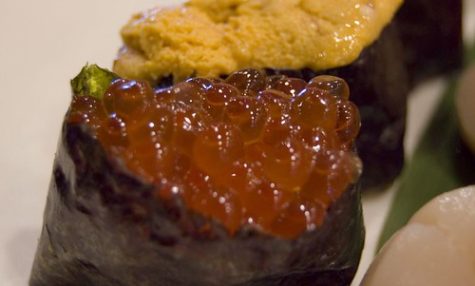
I’m sorry to all of you Finding Nemo fans out there but fish eggs are absolutely amazing. I honestly get how those other fish are feeling when they ate Nemo’s siblings because these things are good. When processing salmon for butchering and such to get the individual parts, none of the salmon go to waste as the ikura is taken from the butchered salmon mother. They are then rinsed gently under water several times so the innards and membrane get removed from them. They are then marinated in soy sauce, dashi, and a variety of other ingredients which then makes them become those shiny little pearls nestled on top of your gunkan maki or your sushi roll. The taste is bursting with the sea mixed with those curing liquids I mentioned before. Variations on this seafood are mainly with other types of this same seafood, being able to be achieved due to molecular gastronomy. However, I’m just here to review food, not a science lesson so I’ll skip over that stuff, though I will say it’s interesting to look over. Pure variations of the eggs themselves are limited but the process of creation keeps it from being at the bottom of the modified list. If you want a thing that’ll give a burst of flavor reminiscent of the sea in each bite of your sushi, fish eggs are the way to go.
Base: 6/10
Modified: 3/10
Overall: 4.5/10
Conclusion and Final Rankings
Base:
- Sea Urchin (10/10 Points)
2/3. Tuna (9/10 Points)
2/3. Mackerel (9/10 Points)
4/5. Salmon (8/10 Points)
4/5. Octopus (8/10 Points)
- Squid (7/10 points)
7/8. Ikura (6/10 Points)
7/8. Scallop (6/10 Points)
- Shrimp (5/10 Points)
- Eel (5/10 Points)
Modified:
1. Salmon (10/10 Points)
2. Tuna (8/10 Points)
3. Shrimp (7/10 Points)
4. Scallop (6/10 Points)
5. Mackerel (4/10 Points)
6. Eel (3/10 Points)
7. Squid (3/10 Points)
8. Ikura (3/10 Points)
9. Uni (2/10 Points)
10. Octopus (1/10 Point)
Overall:
1. Salmon (9/10 Points)
- Tuna (8.5/10 Points)
- Mackerel (6.5/10 Points)
4/5/6. Uni (6/10 Points)
4/5/6. Scallop (6/10 Points)
4/5/6. Shrimp (6/10 Points)
- Squid (5/10 Points)
8/9. Octopus (4.5/10 Points)
8/9. Ikura (4.5/10 Points)
- Eel (4/10 Points)
Doing this list, I have made several realizations. Honestly, despite the ranking system I put into place here, there’s no such thing as bad sushi at a good restaurant. These rankings are not indicators of which are my favorites and are not an end-all-be-all ranking for sushi, I am just one guy commenting on what I observe. Of course, some of my personal favorites are higher up but if it was purely a personal favorites ranking, the rankings would change. The art of sushi takes time and it takes years to master in some cases so I feel each and every piece should be enjoyed to the fullest and savored. I applaud and appreciate the work of sushi chefs around the world because of the dedication that goes into it to make an amazing piece of sushi. Food is a fuel of life, an art form, and something of beauty and spectacle. That being said, I love food and I love to share my passion for such with all of you reading this. Thank you all for reading this and let me know in the comments if there’s anything else you want me to cover. Have a good day everyone!





































